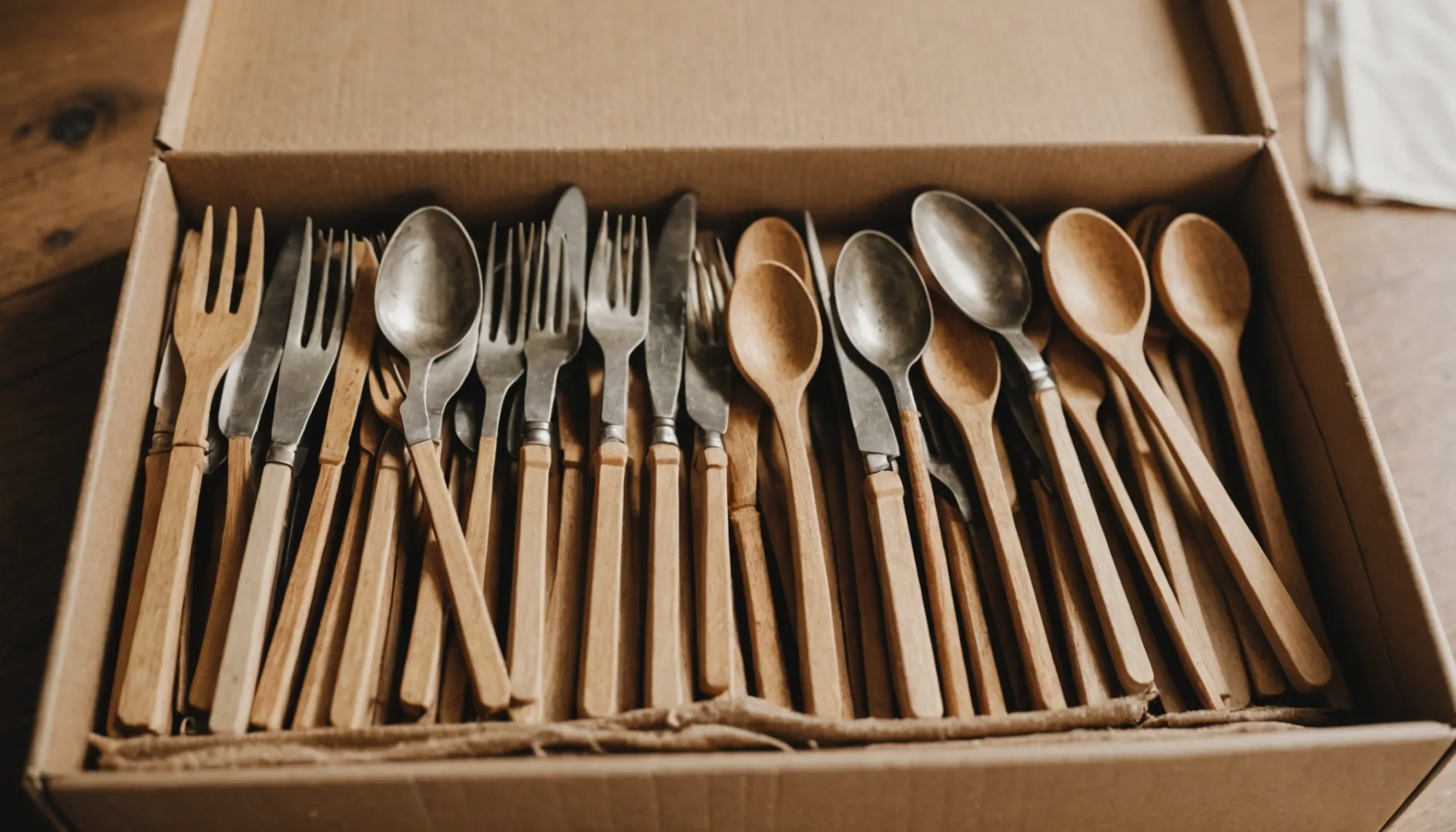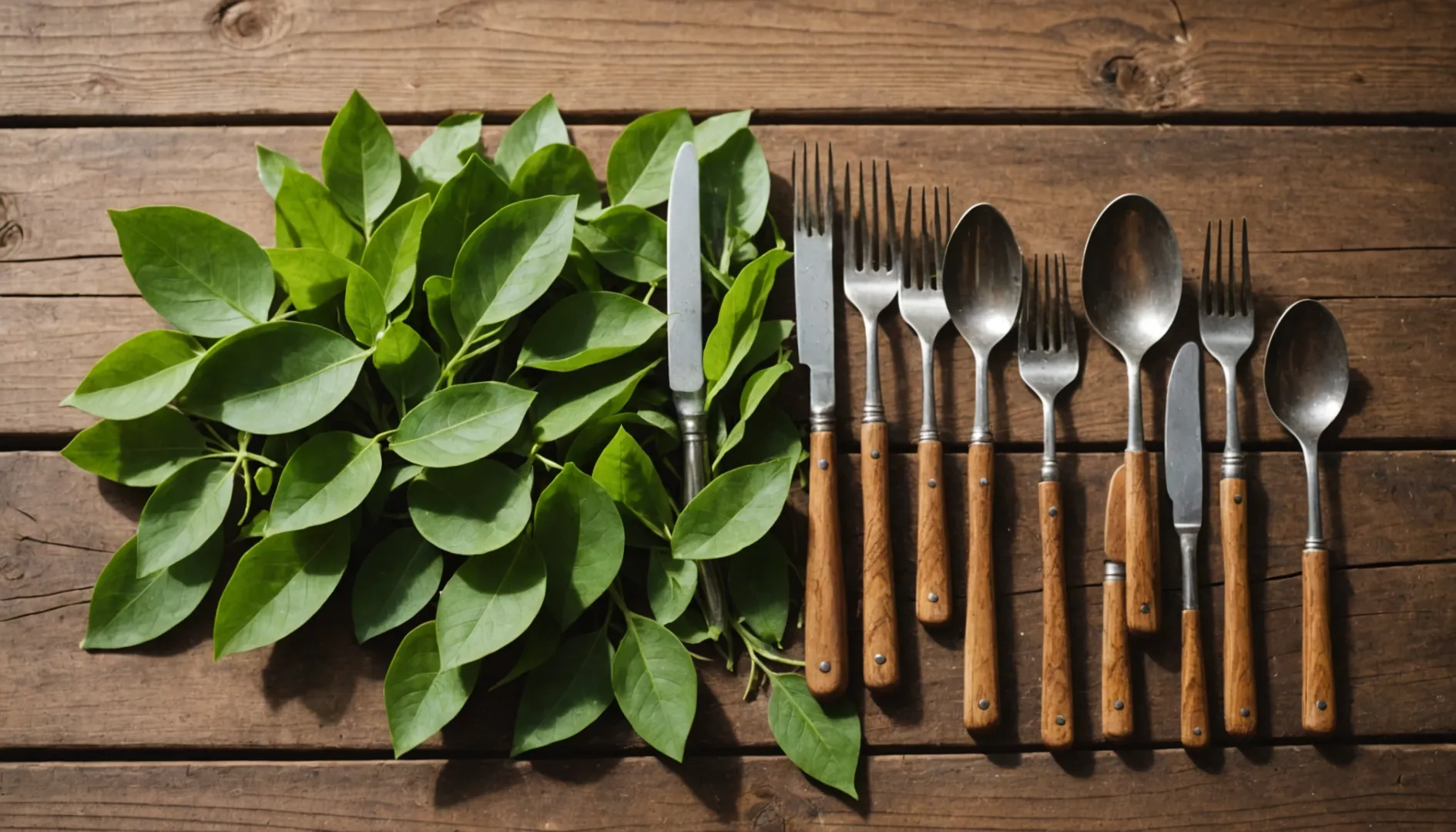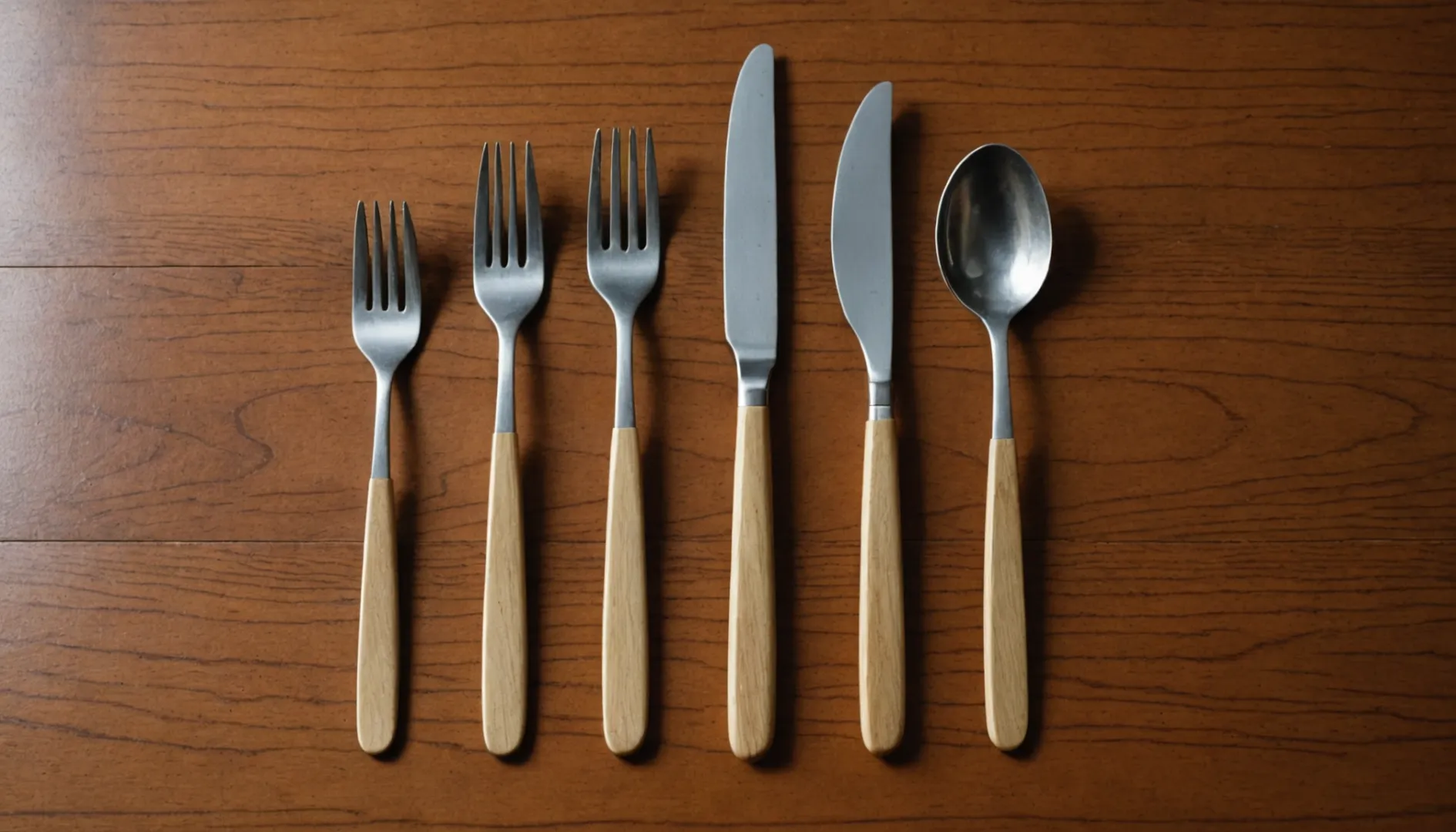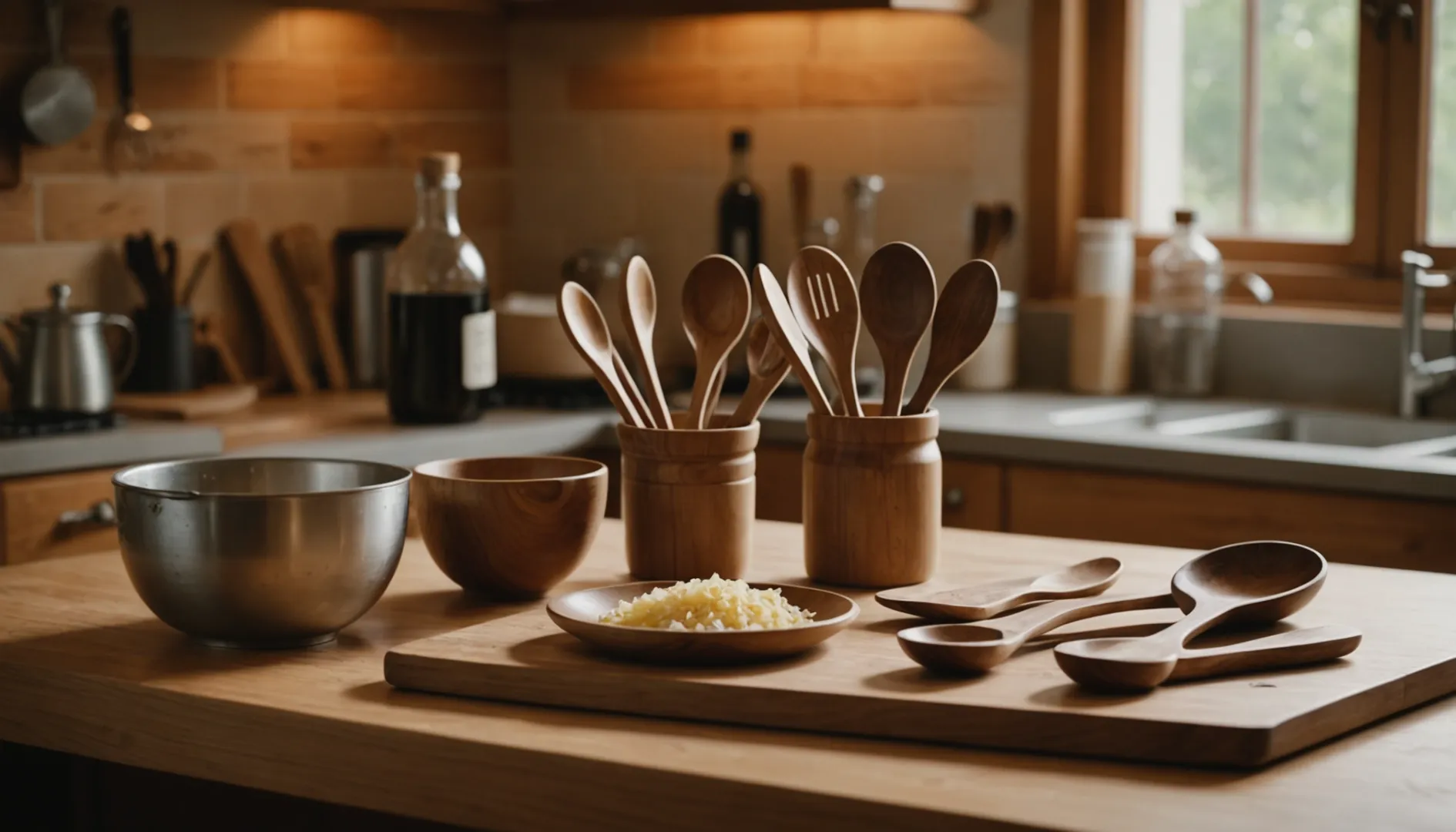
Are you considering a shift towards more sustainable dining solutions for your business? Disposable wooden cutlery might be the answer.
Disposable wooden cutlery is favored in bulk ODM orders due to its sustainability, biodegradability, and eco-friendly manufacturing processes. Unlike plastic, it decomposes quickly and reduces environmental impact, aligning with global eco-conscious trends.
While the initial benefits of choosing wooden over plastic are clear, there are deeper insights into its lifecycle, sourcing strategies, and care that are crucial for making an informed decision. Dive deeper to understand how these factors can affect your business.
Wooden cutlery decomposes faster than plastic.True
Wooden cutlery breaks down naturally within months to years, unlike plastic.
What Are the Environmental Benefits of Wooden Cutlery?
In a world increasingly conscious of environmental impact, wooden cutlery emerges as a sustainable dining alternative. But what are its true ecological benefits?
Wooden cutlery offers significant environmental advantages by being biodegradable, sourced from renewable materials, and free from harmful chemicals. It decomposes faster than plastic, reducing landfill waste, and its production often involves less energy and pollution.

Biodegradability and Decomposition
One of the standout features of wooden cutlery is its ability to break down naturally. Unlike plastic, which can take centuries to decompose, wooden utensils decompose within months to a few years under the right conditions. This property reduces the long-term waste burden on landfills and promotes a healthier environment.
Sourcing from Renewable Resources
The wood used in cutlery is typically sourced from fast-growing trees, making it a renewable resource. Companies often prioritize sourcing from responsibly managed forests1 to ensure sustainability. This approach not only preserves forest ecosystems but also supports biodiversity.
Lower Carbon Footprint
Producing wooden cutlery usually requires less energy compared to plastic counterparts. The processes involved in crafting wooden utensils, such as cutting and shaping wood, tend to emit fewer greenhouse gases. Moreover, wood acts as a carbon sink, absorbing CO2 throughout its life cycle.
Absence of Harmful Chemicals
Unlike many plastic products that may leach toxins into food, wooden cutlery is free from harmful chemicals, making it a safer choice for both consumers and the planet. Manufacturers use natural coatings like beeswax or plant oils to enhance durability and hygiene without compromising environmental safety.
Compostable and Recyclable
At the end of their life, wooden utensils can be composted or recycled. This capability drastically reduces their environmental footprint compared to single-use plastics. Some manufacturers are even innovating with compostable coatings that enhance biodegradability, aiming for products that integrate seamlessly with nature.
Driving Market Demand for Eco-Friendly Products
The rise in demand for wooden cutlery reflects a broader trend towards eco-conscious consumerism. As markets like Europe and North America move towards stricter regulations on single-use plastics, businesses are increasingly opting for eco-friendly alternatives2 that align with consumer values and regulatory requirements.
Challenges and Innovations in Wooden Cutlery
While wooden cutlery is inherently eco-friendly, it faces challenges related to durability and hygiene. Innovations such as combining wood with bamboo fiber or developing compostable coatings are enhancing the performance and appeal of these products. These advancements help address concerns about moisture absorption and bacterial growth, making wooden cutlery a viable long-term solution for sustainable dining.
Wooden cutlery decomposes faster than plastic.True
Wooden cutlery decomposes within months to years, unlike plastic.
Wooden cutlery production emits more greenhouse gases than plastic.False
Producing wooden cutlery generally requires less energy and emits fewer gases.
How Does Wooden Cutlery Compare to Plastic in Bulk Orders?
Wooden cutlery offers a sustainable alternative to plastic, ideal for eco-conscious bulk orders.
Wooden cutlery surpasses plastic in sustainability, offering biodegradability and minimal environmental impact, making it ideal for bulk orders.

Environmental Impact
When considering environmental benefits3, wooden cutlery stands out. Unlike plastic, which can take centuries to decompose, wooden utensils break down naturally and quickly, reducing landfill waste. This makes them a preferred choice for businesses aiming to minimize their carbon footprint in bulk orders.
Durability and Usability
In terms of durability, plastic cutlery often triumphs due to its resistance to moisture and heat. However, wooden cutlery, when properly maintained with natural coatings like beeswax, can offer comparable usability for everyday dining scenarios. It's essential for bulk order clients to understand the care involved to maintain these utensils' longevity.
Cost Implications
While the upfront cost of wooden cutlery may be higher than plastic, long-term benefits such as sustainability certifications4 and reduced waste management costs can offset initial expenses. The table below outlines a cost comparison for an average bulk order:
| Type | Average Cost per 1000 Units | Decomposition Time |
|---|---|---|
| Wooden Cutlery | $200 | Months |
| Plastic Cutlery | $100 | Centuries |
Hygienic Considerations
Wooden utensils can be more porous than plastic, potentially harboring bacteria if not treated with natural oils or coatings. Despite this, many manufacturers ensure that wooden cutlery is food-safe, mitigating health concerns through rigorous testing and quality control.
Market Trends and Consumer Preferences
As consumer preference shifts towards sustainable options, the demand for wooden cutlery in bulk orders is increasing. Regions like North America and Europe lead this trend, driven by regulatory pressures on single-use plastics and growing environmental awareness among consumers.
To truly harness the potential of wooden cutlery in bulk orders, businesses must weigh these factors carefully, ensuring they align with both their operational needs and environmental goals.
Wooden cutlery decomposes faster than plastic.True
Wooden cutlery decomposes in months, while plastic takes centuries.
Plastic cutlery is more sustainable than wooden.False
Plastic cutlery has a higher environmental impact and longer decomposition time.
What Maintenance Practices Ensure Longevity of Wooden Utensils?
Wooden utensils are cherished for their natural beauty and eco-friendliness, but they require proper care to ensure durability.
To extend the life of wooden utensils, regularly apply food-safe oils, avoid soaking in water, and hand wash them gently. Proper drying and storage further prevent warping and bacterial growth, maintaining both hygiene and functionality.

Understanding the Unique Needs of Wooden Utensils
Wooden utensils offer a rustic charm unmatched by other materials, yet their porous nature demands a thoughtful approach to maintenance. Unlike metal or plastic, wood can absorb moisture, leading to potential warping or bacterial proliferation if neglected. This unique attribute necessitates a consistent care regimen.
Regular Oiling for Durability
To keep wooden utensils from drying out or cracking, it's essential to periodically treat them with food-safe oils like mineral oil or coconut oil. This practice not only rejuvenates the wood but also adds a protective layer that enhances resistance to moisture. For detailed guidance on oiling, consider exploring resources such as best oils for wooden utensils5.
| Recommended Oils | Benefits |
|---|---|
| Mineral Oil | Non-toxic and odorless, excellent for sealing wood |
| Coconut Oil | Provides a natural aroma and is antimicrobial |
| Beeswax | Adds a protective finish and enhances sheen |
Cleaning and Drying: Key Practices
Handwashing wooden utensils is crucial. Use mild soap and warm water, avoiding harsh detergents that can strip away natural oils. Never soak them for prolonged periods, as excessive water exposure can lead to swelling or cracking. Once washed, thoroughly dry them with a towel and store in a dry place. For more tips on cleaning wooden kitchen tools, check out proper cleaning methods for wood utensils6.
Avoiding Extreme Temperatures
Exposure to high heat can severely damage wooden utensils. Avoid placing them near stoves or dishwashers where temperatures can weaken the wood structure. Instead, let them air dry naturally in a well-ventilated area.
Storing Wooden Utensils Correctly
Proper storage is often overlooked but is pivotal in prolonging the life of your wooden kitchenware. Store them in a well-ventilated drawer or utensil holder away from direct sunlight to prevent fading or warping. For more on optimal storage solutions, consider visiting wooden utensil storage tips7.
Wooden utensils should be soaked in water.False
Soaking wooden utensils can cause swelling and cracking, reducing lifespan.
Mineral oil is recommended for treating wooden utensils.True
Mineral oil is non-toxic, odorless, and excellent for sealing wood.
How Can Businesses Ensure Responsible Sourcing of Wooden Cutlery?
In the quest for sustainability, businesses are increasingly turning to wooden cutlery. But how can they ensure it's sourced responsibly?
To ensure responsible sourcing of wooden cutlery, businesses should prioritize eco-certifications like FSC, implement transparent supply chains, and adopt sustainable harvesting practices. These steps ensure environmental integrity and align with consumer demand for eco-friendly products.

Understanding Eco-Certifications
Eco-certifications play a pivotal role in guaranteeing the responsible sourcing of wooden cutlery. Labels such as Forest Stewardship Council (FSC)8 certification assure buyers that the wood used comes from sustainably managed forests. These certifications ensure that environmental, social, and economic standards are upheld throughout the supply chain.
Another crucial certification is the Life Cycle Analysis (LCA), which provides data on the environmental impact of production processes, from raw material extraction to disposal. By adopting LCA, businesses can showcase their commitment to sustainability, enhancing brand credibility in eco-conscious markets.
The Importance of Supply Chain Transparency
Transparency in the supply chain is becoming a non-negotiable aspect of responsible sourcing. Technologies such as blockchain9 offer innovative solutions for tracing the origin of wood materials, ensuring they are legally and sustainably harvested. This traceability not only bolsters consumer trust but also aligns with stringent environmental regulations.
By embracing supply chain transparency, businesses can provide verifiable data about their product's origins, fostering a narrative of sustainability that resonates with environmentally aware consumers.
Sustainable Harvesting Practices
Responsible sourcing begins with sustainable harvesting practices. Ensuring that wood is sourced from forests that are replanted and managed responsibly is vital. Companies should collaborate with suppliers who engage in selective logging, allowing forests to regenerate naturally and maintain biodiversity.
Additionally, employing local labor for harvesting can enhance community livelihoods and ensure compliance with fair trade practices.
Innovative Design and Material Use
Innovative design approaches can significantly reduce the environmental footprint of wooden cutlery. For instance, some companies are experimenting with minimalist designs that use less wood without compromising durability. Others are exploring combinations with materials like bamboo fiber to enhance strength and longevity.
By focusing on resource efficiency and waste reduction, businesses can further their commitment to sustainability.
Consumer Education and Engagement
Educating consumers about the importance of responsible sourcing is essential for driving demand for sustainably produced wooden cutlery. Social media campaigns highlighting the environmental benefits and storytelling about the supply chain journey can effectively engage consumers.
Empowered consumers are more likely to support brands that prioritize ethical practices, making education a key component of responsible sourcing strategies.
FSC certification ensures sustainable forest management.True
FSC certification verifies wood is sourced from responsibly managed forests.
Blockchain cannot improve supply chain transparency.False
Blockchain enhances traceability, ensuring legal and sustainable sourcing.
Conclusion
Choosing disposable wooden cutlery supports sustainability goals and enhances your brand's eco-friendly image. Evaluate sourcing practices and maintenance to maximize benefits, ensuring your business aligns with both environmental and consumer expectations.
-
Understand the environmental benefits of sourcing wood sustainably.: Sustainable forestry aims to meet human needs for timber and other forest resources in a way that maintains the forest's health for generations ... ↩
-
Explore eco-friendly dining options as regulations tighten.: Introduction · Reusable Water Bottles · Reusable Sandwich Bags/Containers · Reusable Grocery Bags · Reusable Straws · Sustainable Toothbrushes · Links ... ↩
-
Explore why wooden cutlery is environmentally superior to plastic.: One of the main sustainability benefits of disposable wooden utensils is that they can be composted. Composting ensures that a majority of the carbon and ... ↩
-
Learn about certifications that enhance credibility and market appeal.: Discover essential eco-certifications like FDA, LFGB, and FSC for ensuring the safety and sustainability of wooden cutlery. ↩
-
Learn how different oils protect and enhance wooden utensils.: Linseed oil is a popular choice among woodworkers, but even food-grade linseed oil comes with warnings of spontaneous fires. Refractionated ... ↩
-
Discover effective techniques for cleaning wooden kitchen tools safely.: "Scrub the surface with the cut side of a halved lemon or with a baking soda and water paste," Malt says. "Or, you can simply sprinkle baking ... ↩
-
Explore ideas for storing wooden utensils to maintain their quality.: First things first: Empty your utensil drawer(s) and lay all of the contents out. "Identify the items you reach for regularly and set those ... ↩
-
Learn how FSC certification ensures sustainable forest management.: Certification. FSC certification ensures that products come from responsibly managed forests that provide environmental, social and economic benefits. ↩
-
Discover how blockchain ensures traceability in sourcing.: Blockchain can greatly improve supply chains by enabling faster and more cost-efficient delivery of products, enhancing products' traceability, improving ... ↩

